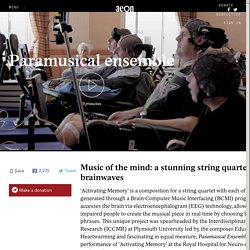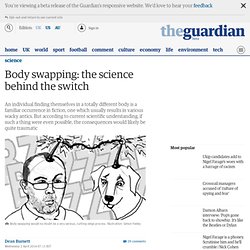

Scientists Demonstrate Direct Brain-to-Brain Communication in Humans. Direct brain-to-brain communication has been a subject of intense interest for many years, driven by motives as diverse as futurist enthusiasm and military exigency.

In his book Beyond Boundaries one of the leaders in the field, Miguel Nicolelis, described the merging of human brain activity as the future of humanity, the next stage in our species’ evolution. (Nicolelis serves on Scientific American’s board of advisers.) He has already conducted a study in which he linked together the brains of several rats using complex implanted electrodes known as brain-to-brain interfaces. Nicolelis and his co-authors described this achievement as the first “organic computer” with living brains tethered together as if they were so many microprocessors.
The animals in this network learned to synchronize the electrical activity of their nerve cells to the same extent as those in a single brain. Changes in cortical network connectivity with long-term brain-machine interface exposure after chronic amputation. Neurophysiology and recordings Three rhesus (Macaca Mulatta) monkeys (monkeys Z, N and K) with chronic unilateral amputation of the upper limb were used in this experiment.

The monkeys had received therapeutic amputations prior to our receiving them for these experiments. Changes in cortical network connectivity with long-term brain-machine interface exposure after chronic amputation. Neurophysiology and recordings Three rhesus (Macaca Mulatta) monkeys (monkeys Z, N and K) with chronic unilateral amputation of the upper limb were used in this experiment.

The monkeys had received therapeutic amputations prior to our receiving them for these experiments. The amputations were required to rescue them following injuries to their arm, and were not amputated for the purposes of this experiment. Monkey Z had a transradial amputation and monkeys K and N had elbow disarticulation amputation ~ 10, 9 and 4 years before they arrived to our lab. Changes in cortical network connectivity with long-term brain-machine interface exposure after chronic amputation. Untitled. How We'll Eventually Control Everything With Our Minds - Motherboard. Music of the mind: a stunning string quartet created through brainwaves. ‘Activating Memory’ is a composition for a string quartet with each of the instruments’ parts generated through a Brain-Computer Music Interfacing (BCMI) program.

This program directly accesses the brain via electroencephalogram (EEG) technology, allowing four severely motor-impaired people to create the musical piece in real-time by choosing between four different musical phrases. This unique project was spearheaded by the Interdisciplinary Centre for Computer Music Research (ICCMR) at Plymouth University led by the composer Eduardo Reck Miranda. This Wearable MRI Device Could Help Us Read Minds. In Brief Mary Lou Jepsen, former head of display technology at Oculus, has founded a startup called Openwater that hopes "to create a wearable to enable us to see the inner workings of the body and brain at high resolution.

" DARPA-funded Efforts in the Development of Novel Brain–Computer Interface Technologies. Abstract The Defense Advanced Research Projects Agency (DARPA) has funded innovative scientific research and technology developments in the field of brain–computer interfaces (BCI) since the 1970s.

This review highlights some of DARPA’s major advances in the field of BCI, particularly those made in recent years. Two broad categories of DARPA programs are presented with respect to the ultimate goals of supporting the nation’s warfighters: (1) BCI efforts aimed at restoring neural and/or behavioral function, and (2) BCI efforts aimed at improving human training and performance. The programs discussed are synergistic and complementary to one another, and, moreover, promote interdisciplinary collaborations among researchers, engineers, and clinicians. Ahmad Ali's answer to Productivity: What is the best study method.
Ahmad Ali's answer to Productivity: What is the best study method. Amber Case: We are all cyborgs now. Future - Beyond human: How I became a cyborg. When writer Frank Swain joined the ranks of the cyborgs, he discovered that it meant losing control of a part of his body.

In the first of our Beyond Human series, he explores why enhancing the senses raises surprising personal and ethical problems. Listen: What does red or green sound like? In the clip above from BBC Radio 4’s Hack My Hearing, Frank Swain meets an artist who created a unique device allowing him to hear colours. Body swapping: the science behind the switch.
Next year sees the release of the Ben Kingsley/Ryan Reynolds film Selfless, where a wealthy elderly dying man transfers his consciousness from his diseased and ravaged body into a younger, sexier one.

This is quite a familiar trope in fiction, the body swap, where a character finds his or herself inhabiting a completely different body. Alternatively, there’s David Brin’s Kiln People (one of my favourite ever sci-fi books) which invents a whole new field of science to explain it. In this world the mind can be copied and transferred into duplicates, but never swapped between humans.
If there is any science behind body swapping, we don’t know what it is, so don’t know how it would be done. A “brain transplant” would be less than ideal as it would be indescribably difficult; even if you could reconnect the millions of neurones between brain and spinal cord, nerve cells don’t regenerate very well. Wearable Neurocam. The "neurocam" is a wearable device that can detect emotions via brainwaves, and automatically records "scenes" based on the wearer's interest level.

From KurzweilAI: The algorithm is based on measures of “interest” and “like” developed by Professor Mitsukura and the neurowear team.The users interests are quantified on a range of 0 to 100. The camera automatically records five-second clips of scenes when the interest value exceeds 60, with timestamp and location, and can be replayed later and shared socially on Facebook. Gender Swap – Experiment with The Machine to Be Another. Gender Swap - Experiment with The Machine to Be Another. Mice can 'warn' sons, grandsons of dangers via sperm › News in Science (ABC Science)
News in Science Monday, 2 December 2013 ABC.

The Pomodoro Technique® What is The Pomodoro Technique? Injectable, Cellular-Scale Optoelectronics with Applications for Wireless Optogenetics. Successful integration of advanced semiconductor devices with biological systems will accelerate basic scientific discoveries and their translation into clinical technologies. In neuroscience generally, and in optogenetics in particular, the ability to insert light sources, detectors, sensors, and other components into precise locations of the deep brain yields versatile and important capabilities. Here, we introduce an injectable class of cellular-scale optoelectronics that offers such features, with examples of unmatched operational modes in optogenetics, including completely wireless and programmed complex behavioral control over freely moving animals.
The ability of these ultrathin, mechanically compliant, biocompatible devices to afford minimally invasive operation in the soft tissues of the mammalian brain foreshadow applications in other organ systems, with potential for broad utility in biomedical science and engineering. Non-Invasive Brain-to-Brain Interface (BBI): Establishing Functional Links between Two Brains. Transcranial focused ultrasound (FUS) is capable of modulating the neural activity of specific brain regions, with a potential role as a non-invasive computer-to-brain interface (CBI).
In conjunction with the use of brain-to-computer interface (BCI) techniques that translate brain function to generate computer commands, we investigated the feasibility of using the FUS-based CBI to non-invasively establish a functional link between the brains of different species (i.e. human and Sprague-Dawley rat), thus creating a brain-to-brain interface (BBI).
The implementation was aimed to non-invasively translate the human volunteer’s intention to stimulate a rat’s brain motor area that is responsible for the tail movement. Apps use brainwaves to guide, improve meditation. A Brain-to-Brain Interface for Real-Time Sharing of Sensorimotor Information : Scientific Reports. In our training paradigm, animals learned basic elements of the tasks prior to participating in any BTBI experiments. First, prospective encoder rats were trained to respond to either tactile or visual stimuli until they reached 95% correct trials accuracy. Meanwhile, decoder rats were trained to become proficient while receiving ICMS as a stimulus. A train of ICMS pulses instructed the animal to select one of the levers/nose pokes, whereas a single ICMS pulse instructed a response to the other option.
Decoder rats reached a 78.77% ± 2.1 correct trials performance level. After this preliminary training was completed, the animals were run in pairs, each one in a separate operant box. The next phase of training began with the encoder rat performing ~10 trials of the motor or tactile task, which were used to construct a cortical ensemble template, i.e. the mean cortical neuronal activity for one of the responses.
Full size image (222 KB) Full size image (314 KB) Full size image (155 KB) The Amazing Story Of The $300 Glasses That Correct Colorblindne. If it were up to academia, Changizi's story might have ended there. "I started out in math and physics, trying to understand the beauty in these fields," he says, "You are taught, or come to believe, that applying something useful is inherently not interesting. " Not only did Changizi manage to beat that impulse out of himself, but he and Tim Barber, a friend from middle school, teamed up several years ago to form a joint research institute. 2AI Labs allows the pair to focus on research into cognition and perception in humans and machines, and then to commercialize it.
Untitled. February 19th, 2013 | by Charles Q. Is bionic vision about to become a reality? Insect drives robot to track down smells (w/ video) Emotions are included. New Republic has an interesting piece on how corporations enforce ‘emotional labour’ in their workforce – checking that they are being sufficiently passionate about their work and caring to their customers. It focuses on the UK sandwich chain Pret who send a mystery shopper to each outlet weekly and “If the employee who rings up the sale is appropriately ebullient, then everyone in the shop gets a bonus. Labor of Love. Technology - Will we ever… have cyborg brains? After recent triumphs showing that implants could repair lost brain function, Martin W. The revolutionary 'contact lens' loaded with stem cells that restores sight - by helping the eye heal itself naturally. Text messages direct to your contact lens.
Neurorobotics: Brain Machine Interfaces. Hyperscanning - the g.tec way of wishing "Merry Christmas" Neuroscience: The mind reader. Identity. Reading Visual Braille with a Retinal Prosthesis. 1Second Sight Medical Products, Sylmar, CA, USA 2Brigham Young University – Idaho, Rexburg, ID, USA 3UMR-S 968, Institut de la Vision, Paris, France 4CIC INSERM DHOS 503, National Ophthalmology Hospital, Paris, France Retinal prostheses, which restore partial vision to patients blinded by outer retinal degeneration, are currently in clinical trial. The Argus II retinal prosthesis system was recently awarded CE approval for commercial use in Europe. The remote control helicopter you can control with your mind. The man who hears colour. World Wide Mind. Brain Computer Interface used to control the movement and actions of an android robot. Amputee makes history controlling two modular prosthetic limbs.